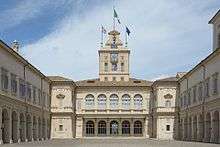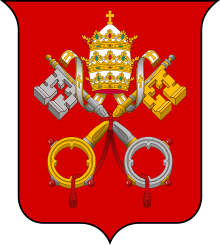Temporal power (papal)
The temporal power or temporal jurisdiction of the popes is the political and secular governmental activity of the popes of the Roman Catholic Church, as distinguished from their spiritual and pastoral activity.
Origins

Pope Gregory II's defiance of the Byzantine emperor Leo III the Isaurian as a result of the first iconoclastic controversy (726 AD) in the Eastern Empire, prepared the way for a long series of revolts, schisms and civil wars that eventually led to the establishment of the temporal power of the popes.
For over a thousand years popes ruled as sovereign over an amalgam of territories on the Italian peninsula known as the Papal States, from the capital, Rome.
Early modern period
Theologian Robert Bellarmine, in his 16th century dogmatic work Disputationes strongly affirmed the authority of the pope as the vicar of Christ. However, he reasoned that since Christ did not exercise his temporal power, nor may the pope.[1] In 1590, Pope Sixtus V had, or very nearly had, the first volume placed on the Index Librorum Prohibitorum for denying temporal hegemony to the papacy.[2][3]
19th century

The temporal power was abolished by Napoleon Bonaparte, who dissolved the Papal States and incorporated Rome and Latium into his French Empire in 1809. The temporal power was restored by the Great Powers at the conclusion of the Napoleonic Wars in the 1815 Congress of Vienna. The Napoleonic civil laws were abolished, and most civil servants were removed from office. Popular opposition to the reconstituted corrupt clerical government led to numerous revolts, which were suppressed by the intervention of the Austrian army.
In November 1848, following the assassination of his minister Pellegrino Rossi, Pope Pius IX fled Rome. During a political rally in February 1849, a young heretic, the Abbé Arduini, described the temporal power of the popes as a "historical lie, a political imposture, and a religious immorality."[4] On 9 February 1849, the newly elected Roman Assembly proclaimed the Roman Republic. Subsequently, the Constitution of the Roman Republic[5] abolished the temporal power, although the independence of the pope as head of the Catholic Church was guaranteed by article 8 of the "Principi fondamentali".
At the end of June 1849, the Roman Republic was crushed by 40,000 French troops sent by Louis Napoleon Bonaparte (later Napoleon III), at the urging of the ultramontane French clerical party. The temporal power was restored and propped up by a French garrison.
In 1859–60, the Papal States lost Romagna, Marche and Umbria. These regions were incorporated into the Kingdom of Italy, and the temporal power was reduced to Rome and the region of Lazio. At this point, some ultramontane groups proposed that the temporal power be elevated into a dogma. According to Raffaele De Cesare:
The first idea of convening an Ecumenical Council in Rome to elevate the temporal power into a dogma, originated in the third centenary of the Council of Trent, which took place in that city in December, 1863, and was attended by a number of Austrian and Hungarian prelates.[6]
However, following the Austro-Prussian War, Austria had recognized the Kingdom of Italy. Thus the revival of the temporal power of the Bishop of Rome was deemed impossible. Some, primarily Italian, clergy suggested an ecumenical council to dogmatically define papal infallibility as an article of faith, binding upon the consciences of all Catholic faithful. This doctrinal view, however, initially proposed by Franciscan partisans in opposition to the prerogative of Popes to contradict the more favorable decrees of their predecessors, faced significant resistance outside of Italy prior to and during the First Vatican Council.[7]
For practical purposes, the temporal power of the popes ended on 20 September 1870, when the Italian Army breached the Aurelian Walls at Porta Pia and entered Rome. This completed the Risorgimento. The pope's alternative claims to reign in religion and to reign in a state were reflected in the possession of two official papal residences: the Apostolic Palace in the Vatican, which served as their official religious residence, and the Quirinal Palace, which was their official residence as sovereign of the Papal States. In 1870 papal rule in the Papal States was deposed; the territories were included in the territory of the Kingdom of Italy with Kings of Italy using the Quirinale as their official state palace.
20th century

Popes continued to assert that their deposition from temporal jurisdiction in the Papal States was illegal until 1929. Catholics were prohibited from voting in Italian elections and Italian state and royal institutions were boycotted as part of their campaign for a return of the papal states. In 1929, with the Lateran Treaty the papacy and the Italian state (then under the dictatorship of Benito Mussolini) agreed to recognise each other, with the state paying the Church compensation for the loss of the territories. The pope was recognised as sovereign of a new state, the Vatican City, over which he continues to exert temporal power.
On 20 September 2000, an item in the Catholic publication Avvenire stated:
That in 1970, precisely on 20 September 1970, Pope Paul VI sent Cardinal Angelo Dell'Acqua, his vicar for Rome, to Porta Pia to celebrate the "providential" significance of the loss of the temporal power. Since then, at least since then, Porta Pia has also been a Catholic celebration!
The Papal Coronation and the papal crown (the Papal Tiara) were both interpreted as reflecting a continuing claim to temporal jurisdiction by the papacy. However, in his homily at his October 1978 Papal Inauguration, Pope John Paul II dismissed that claim and asserted that the papacy had long had no wish to possess any temporal jurisdiction outside the Vatican.
See also
- Caesaropapism
- Donation of Constantine
- Donation of Pepin
- Gregorian Reform
- Interdict
- Investiture Controversy
- National Catholicism
- Neo-ultramontanism
- Papal deposing power
- Papal Jurisdiction Act 1560
- Papal States
- Papal supremacy
- Political Catholicism
- Political theology
- Pontifex Maximus
- Primacy of the Bishop of Rome
- Sic transit gloria mundi
- Symphonia (theology)
- Theocracy
- Ultramontanism
- Vatican City
Notes
- ↑ Patricia Springborg. "Thomas Hobbes and Cardinal Bellarmine". History of Political Thought. XVI:4 (Winter 1995), pp. 503-531: 516-517.
- ↑ "St. Robert Francis Romulus Bellarmine".
- ↑ "DOCTORS OF THE CHURCH (sep14doc.htm)".
- ↑ Jasper Ridley, Garibaldi, Viking Press (1976) p. 268
- ↑ "Archived copy". Archived from the original on 2013-09-27. Retrieved 2013-09-27.
- ↑ De Cesare, Raffaele (1909). The Last Days of Papal Rome. Archibald Constable & Co. p. 422.
- ↑ De Cesare, Raffaele (1909). The Last Days of Papal Rome. Archibald Constable & Co. p. 423.
